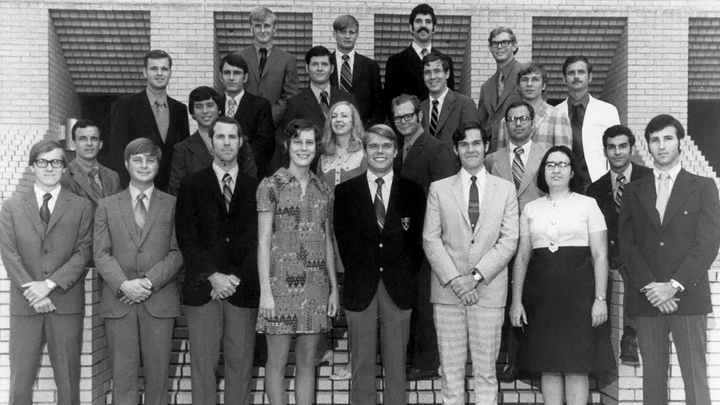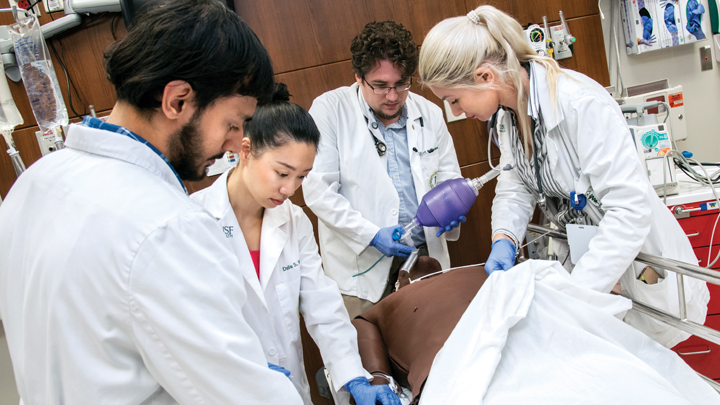Current Features
Golden Doctors

IN SEPTEMBER 1971, THE DOORS of Florida’s newest medical school opened to 24 students, launching an MD program at USF that has since grown to be one of the top producers of physicians in the state.
The new students in this charter class – 21 men and three women – along with charter faculty and support staff, took a bit of a gamble those 50 years ago when they joined a school with no history of a quality medical curriculum and barely provisional accreditation.
Founding Dean Dr. Donn L. Smith assured the group all would be fine, and that the school would provide an advantageous student-to-faculty ratio and an open-door policy.
The community backed this medical school from the start. Although, as with many community and legislative decisions, a college of medicine in Tampa was not completed quickly, nor quietly.
The founding may have truly begun in 1959, when President Dwight Eisenhower’s administration identified a physician shortage and pushed to the forefront the need for not only an enlargement of classes, but also for adding more medical schools.
Then, in 1963, President John F. Kennedy’s administration and Congress passed the Health Professions Educational Assistance Act, which included appropriations of $175 million to help pay for up to two-thirds of the construction costs of new medical schools. This lit a fire under Tampa-area and Florida elected officials, including Rep. Sam Gibbons. And fuel was added to that fire when the administration of President Lyndon Johnson, with its legislation launching Medicare and Medicaid, accelerated the need for solving the physician shortage.
Helping to sell the point that USF made the most sense for Florida’s newest medical school was the university’s location next to the site planned for the new veterans’ hospital in Tampa – the James A. Haley Veterans’ Hospital – as well as the city’s proximity to the already established veterans’ hospital in Bay Pines in Pinellas County.
These critical early steps, coupled with a lot of Florida politicking, resulted in Florida Gov. W. Haydon Burns signing into law in 1965 the edict to open both a college of medicine and a college of nursing at USF in Tampa.
Considered a victory, there was still a catch – that law included no set appropriations. There was approval to build the schools but no state money for construction, not even with the promise of having to foot only one-third of the bill, which would have been $7 million. The federal coffers would pay the remaining two-thirds, totaling $14 million.
To move that appropriation forward, a 100-page report was created in 1966, laying out the plans for construction, teaching, curriculum, timeline and proposed funding from the Florida Legislature. The report included plans for both a medical school and an assumed required teaching hospital. It also incorporated a teaching approach that leaned heavily on clinics and hospitals throughout the region – veterans hospitals, private medical practices, several major hospitals, etc. – calling it an “open medical school” that would use lots of community-based resources.
After much wrangling and passing of even more time, the 1967 Florida Legislature approved the funding for the USF medical school – but not all $7 million requested. They scratched the idea of the teaching hospital and appropriated only $3 million, pointing to the report’s own idea that the medical school could rely largely on existing clinical facilities across the community to teach medical students, and suggesting that this be the framework for the new USF medical school moving forward.
And thus, the medical school received its appropriation from the Florida Legislature and the medical school could finally start. Celebrations rippled across the community, and the July 21, 1967, editorial headline of The Tampa Tribune declared “A Medical Victory” noting: “It is a project which sparkles with promise of benefits, both medical and economic, for the Tampa area.” The editorial went on to praise the many hands across the city, county and state that helped support the medical school, including chambers of commerce, elected officials and local physicians – a true community effort.
When classes began in September 1971 for USF’s 24 founding medical students, they were held in a 30-foot by 40-foot room on the fourth floor of the Science Center on the USF campus; the facilities for what would become the Health Sciences Center and USF Health were not yet built. This lecture hall was a cordoned-off corner of a laboratory, but the make-do space didn’t curb the excitement of these future physicians. Such an arduous and modest start helped set a strong foundation for future first-year students, and helped to build what is now the USF Health Morsani College of Medicine, one of the highest-quality medical education programs in Florida.
Although starting small with 24 students, and for many years holding at 96 as the class size for new students, the program today welcomes about 175 first-year students each year.
This fall marks the 50th anniversary of this charter class, a milestone that will be celebrated across the next few years. The first few classes of the USF medical school completed a three-year curriculum (today’s MD program is four years), so celebrations will culminate in spring 2024 with the 50-year recognition of the first MD class graduation.
Karl Altenburger
Rufus Armstrong
Douglas Barrett
Loren Bartels
Thomas G. Bell
Grant P. Carmichael
M. Dexter Clayton, III
John W. Demetree
Joseph F. Dibble
Gary L. Dunlap
John M. Elliott
Sheila F. Farmer
John M. Hellrung
Russell Jenna, Jr.
Robert Martinez
Luther M. McEachern
William D. Parker
Gary G. Peterson
Gregory J. Piacente
Caroline J. Setzer
M. Lindsay Struthers
Stephen Vernon
Joseph C. Wheeler, III
Gary E. Winchester
Walter E. Afield, MD, psychiatry
Carleton H. Baker, MD, physiology
Lewis A. Barness, MD, pediatrics
Roy H. Behnke, MD, internal medicine
Joseph G. Cory, PhD, biochemistry
William C. Edwards, MD, ophthalmology
Charles W. Fishel, PhD, microbiology and immunology
Arthur D. Graham, MD, radiology
James M. Ingram, MD, obstetrics and gynecology
Louis R. Nelson, DVM, laboratory animal medicine
Roger T. Sherman, MD, surgery
Herschel Sidransky, MD, pathology
Andor Szentivanyi, MD, pharmacology and therapeutics
James W. Ward, PhD, anatomy

Class of ’25 strongest in history
USF HEALTH MORSANI COLLEGE OF MEDICINE’S first-year students represent the strongest class academically and the most diverse group of students in the college’s history.
The Class of 2025, which began coursework in late July, set academic records for the medical school by having scored the highest median MCAT score in history, 517, as well as earning the highest average GPA, 3.83. In addition, the new class is more diverse than previous first-year classes, with a record 20% from those groups traditionally underrepresented in medicine (URM).
“We could not be more excited to welcome this exemplary new class of medical students,” says Dr. Charles J. Lockwood, senior vice president of USF Health and dean of the Morsani College of Medicine. “I have long said that USF Health is bringing the best and brightest minds to Tampa Bay, and this record-breaking class is further evidence of the growing strength and reputation of the Morsani College of Medicine. Not only is this the highest-achieving cohort in our history, but it is also the most diverse, and we cannot wait to see all that they will achieve in medical school and beyond.”
Across the last several years, each of the college’s first-year classes has outpaced the class before it with higher MCAT scores and stronger GPAs. This year’s median score of 517 places this class in the 94th percentile ranking for scores across the country.
And compared to seven years ago, when only 6% of the class was from URM groups, this year’s class includes a far more diverse student body. Also improving this year is the acceptance and matriculation of more Black men. In 2014, the class included 2% African Americans, and they were all female. This year’s class included 12% Black students, including 11 males.
The Class of 2025 was selected from a record 6,400 applications, the most applicants in the college’s history, which makes it the most competitive class in the college’s history. Of the nearly 53,000 applicants attempting to find spots this year in the roughly 150 allopathic medical schools in the U.S., more than 6,400 applied to MCOM, which means that each new MCOM student’s chance of being a part of this class was less than 2.8%.